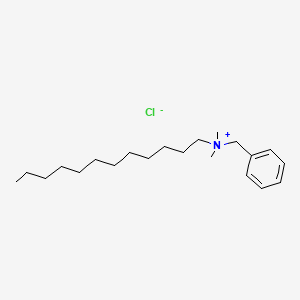Attribution Statement: LactMed is a registered trademark of the U.S. Department of Health and Human Services.
NCBI Bookshelf. A service of the National Library of Medicine, National Institutes of Health.
Drugs and Lactation Database (LactMed®) [Internet]. Bethesda (MD): National Institute of Child Health and Human Development; 2006-.
CASRN: 8001-54-5

Drug Levels and Effects
Summary of Use during Lactation
Topical maternal application of benzalkonium chloride or benzethonium chloride or their presence as a preservative in pharmaceuticals would not be expected to cause any adverse effects in breastfed infants. Household disinfecting sprays and wipes contribute to the benzalkonium chloride content of milk. The effects of long-term exposure of the infant to low levels in milk is not known.
Drug Levels
Maternal Levels. Four women using tampons containing benzalkonium chloride 60 mg provided breast milk samples 15 min prior to tampon application and 3 and 24 h after application. Benzalkonium chloride was not detected in the blood or breastmilk in any of the four subjects using HPLC analysis (assay limit not stated).[1]
A study of 48 women in the Seattle, Washington area ranging in age from 24 to 42 years of age who were breastfeeding their first child manually extracted milk samples for analysis. Milk samples were collected prior to the COVID-19 pandemic. Ninety milk samples containing benzalkonium compounds with alkyl chain lengths ranging from C10 to C18 had a mean total benzalkonium concentration of 1.2 mcg/L. Quaternary ammonium compounds (QACs, including alkyltrimethyl ammonium compounds) were found in breastmilk with at least one QAC found in each sample and 7 QACs detected in more than half of the samples. The highest concentrations of benzalkonium chloride components were of C12 at 0.51 mcg/L and C14 at 0.56 mcg/L. Higher QAC levels in breastmilk were found in mothers who used QAC-containing disinfecting products (especially sprays) and disinfected more often. The authors estimated that fully breastfed infants would receive average daily benzalkonium chloride intake of 138 ng/kg under 1 month of age, 128 ng/kg from 1 to 3 months of age, 102 ng/kg from 3 to 6 months of age and 77 ng/kg between 6 and 12 months of age (nonexclusive breastfeeding), based on variations in milk intake during each time period.[2]
Infant Levels. Relevant published information was not found as of the revision date.
Effects in Breastfed Infants
A study in Japan randomized 80 consecutive term patients into 4 groups who received either povidone-iodine or benzethonium chloride as a skin disinfectant before delivery and one of these for postpartum vaginal lacerations. Prepartum doses were about 7 mL and postpartum doses were about 0.5 mL of solution. Infant thyrotropin levels were elevated in the infants whose mothers received topical povidone-iodine pre- and postpartum compared to infants whose mothers received benzethonium chloride.[3]
Effects on Lactation and Breastmilk
Relevant published information was not found as of the revision date.
Alternate Drugs to Consider
References
- 1.
- Johnson W Jr. Final report on the safety assessment of benzalkonium chloride. J Am Coll Toxicol. 1989;8:589–625.
- 2.
- Zheng G, Schreder E, Sathyanarayana S, et al. The first detection of quaternary ammonium compounds in breast milk: Implications for early-life exposure. J Expo Sci Environ Epidemiol. 2022;32:682–8. [PMC free article: PMC9015285] [PubMed: 35437305]
- 3.
- Koga Y, Sano H, Kikukawa Y, et al. Affect on neonatal thyroid function of povidone-iodine used on mothers during perinatal period. J Obstet Gynaecol (Tokyo). 1995;21:581–5. [PubMed: 8640469]
Substance Identification
Substance Name
Benzalkonium Chloride
CAS Registry Number
8001-54-5
Drug Class
Breast Feeding
Lactation
Milk, Human
Anti-Infective Agents, Local
Antibacterial Agents
Detergents
Preservatives, Pharmaceutical
Disclaimer: Information presented in this database is not meant as a substitute for professional judgment. You should consult your healthcare provider for breastfeeding advice related to your particular situation. The U.S. government does not warrant or assume any liability or responsibility for the accuracy or completeness of the information on this Site.
- User and Medical Advice Disclaimer
- Drugs and Lactation Database (LactMed) - Record Format
- LactMed - Database Creation and Peer Review Process
- Fact Sheet. Drugs and Lactation Database (LactMed)
- Drugs and Lactation Database (LactMed) - Glossary
- LactMed Selected References
- Drugs and Lactation Database (LactMed) - About Dietary Supplements
- Breastfeeding Links
- PMCPubMed Central citations
- PubChem SubstanceRelated PubChem Substances
- PubMedLinks to PubMed
- Review Carbachol.[Drugs and Lactation Database (...]Review Carbachol.. Drugs and Lactation Database (LactMed®). 2006
- New Candidate Preservative in Ophthalmic Solution Instead of Benzalkonium Chloride: 1,3-Didecyl-2-methyl Imidazolium Chloride.[Chem Pharm Bull (Tokyo). 2023]New Candidate Preservative in Ophthalmic Solution Instead of Benzalkonium Chloride: 1,3-Didecyl-2-methyl Imidazolium Chloride.Iwasaki T, Uchiyama R, Nosaka K. Chem Pharm Bull (Tokyo). 2023; 71(7):552-557.
- Review Gentian Violet.[Drugs and Lactation Database (...]Review Gentian Violet.. Drugs and Lactation Database (LactMed®). 2006
- [Optimization of benzalkonium chloride concentration in 0.0015% tafluprost ophthalmic solution from the points of ocular surface safety and preservative efficacy].[Yakugaku Zasshi. 2010][Optimization of benzalkonium chloride concentration in 0.0015% tafluprost ophthalmic solution from the points of ocular surface safety and preservative efficacy].Asada H, Takaoka-Shichijo Y, Nakamura M, Kimura A. Yakugaku Zasshi. 2010 Jun; 130(6):867-71.
- Ecological Risk Analysis for Benzalkonium Chloride, Benzethonium Chloride, and Chloroxylenol in US Disinfecting and Sanitizing Products.[Environ Toxicol Chem. 2022]Ecological Risk Analysis for Benzalkonium Chloride, Benzethonium Chloride, and Chloroxylenol in US Disinfecting and Sanitizing Products.Fuchsman P, Fetters K, O'Connor A, Bock M, Henning M, Brown L, Mrdjen I, Stanton K. Environ Toxicol Chem. 2022 Dec; 41(12):3095-3115. Epub 2022 Nov 9.
- Benzalkonium Chloride - Drugs and Lactation Database (LactMed®)Benzalkonium Chloride - Drugs and Lactation Database (LactMed®)
Your browsing activity is empty.
Activity recording is turned off.
See more...
